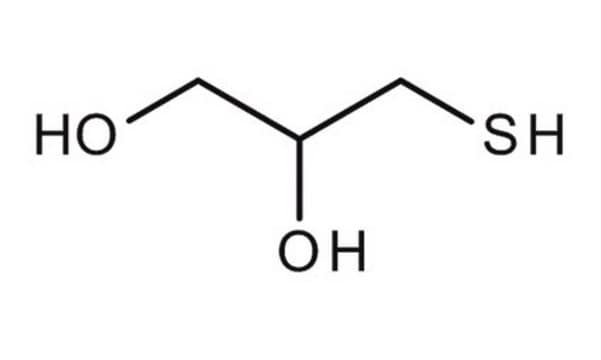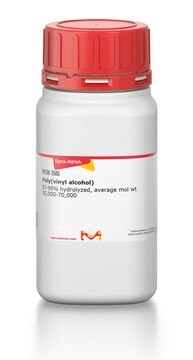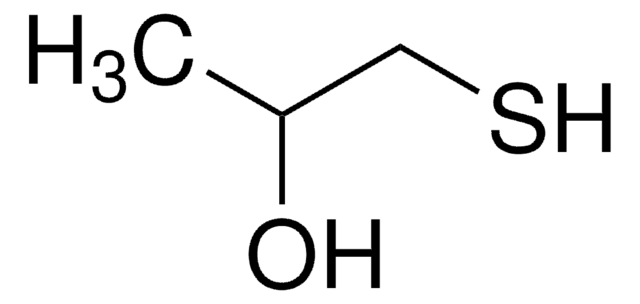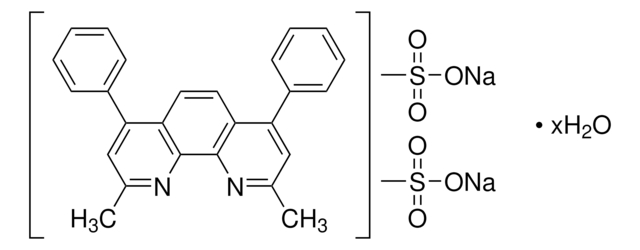To avoid contamination, sterile filtration is highly recommended prior to cell culture application. Upon verification, the lab has not formulated a protocol for cell culture use. However, the following citation on M1753 for cell culture application may be of interest as a protocol reference: Im, H. (2011). "Mouse Embryonic Stem Cell Maintenance for Differentiation." Bio-101: e145. DOI: 10.21769/BioProtoc.145.
M1753
1-Thioglycerol
≥97%
Synonym(s):
α-Monothioglycerol, α-Thioglycerol, 3-Mercapto-1,2-propanediol
About This Item
Recommended Products
Assay
≥97%
form
liquid
refractive index
n20/D 1.527 (lit.)
bp
118 °C/5 mmHg (lit.)
density
1.25 g/mL at 25 °C (lit.)
storage temp.
2-8°C
SMILES string
OCC(O)CS
InChI
1S/C3H8O2S/c4-1-3(5)2-6/h3-6H,1-2H2
InChI key
PJUIMOJAAPLTRJ-UHFFFAOYSA-N
Looking for similar products? Visit Product Comparison Guide
General description
Application
Preparation Note
Signal Word
Danger
Hazard Statements
Precautionary Statements
Hazard Classifications
Acute Tox. 3 Dermal - Acute Tox. 3 Inhalation - Acute Tox. 4 Oral - Skin Irrit. 2 - Skin Sens. 1B
Storage Class Code
6.1C - Combustible acute toxic Cat.3 / toxic compounds or compounds which causing chronic effects
WGK
WGK 3
Flash Point(F)
210.2 °F - closed cup
Flash Point(C)
99 °C - closed cup
Personal Protective Equipment
Choose from one of the most recent versions:
Already Own This Product?
Find documentation for the products that you have recently purchased in the Document Library.
Customers Also Viewed
-
What could be causing contamination of cell culture experiments while using M1753? Also, how should M1753 be added to the cell culture media?
1 answer-
Helpful?
-
-
What is the concentration of the 1-thioglycerol?
1 answer-
The liquid is not a solution of 1-thioglycerol in some solvent. Rather, it is a neat liquid (i.e., essentially pure 1-thioglycerol). Based on a density of 1.245 g/mL and a molecular weight of 108.2 g/mole, one can calculate an effective molarity of 11.5 M. This information may be found on the M1753 product information sheet.
Helpful?
-
-
What is the Department of Transportation shipping information for this product?
1 answer-
Transportation information can be found in Section 14 of the product's (M)SDS.To access the shipping information for this material, use the link on the product detail page for the product.
Helpful?
-
-
How does the storage temperature relate to shipping conditions?
1 answer-
The storage conditions that a Sigma-Aldrich catalog and label recommend for products are deliberately conservative. For many products, long-term storage at low temperatures will increase the time during which they are expected to remain in specification and therefore are labeled accordingly. Where short-term storage, shipping time frame, or exposure to conditions other than those recommended for long-term storage will not affect product quality, Sigma-Aldrich will ship at ambient temperature. The products sensitive to short-term exposure to conditions other than their recommended long-term storage are shipped on wet or dry ice. Ambient temperature shipping helps to control shipping costs for our customers. At any time, our customers can request wet- or dry-ice shipment, but the special handling is at customer expense if our product history indicates that the product is stable for regular shipment.
Helpful?
-
Active Filters
Our team of scientists has experience in all areas of research including Life Science, Material Science, Chemical Synthesis, Chromatography, Analytical and many others.
Contact Technical Service









